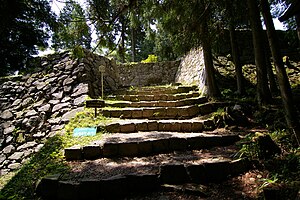
This is a list of female castellans in Japanese history.
Definition

The list includes the following persons:
- Women who inherited the leadership of a samurai clan.
- A woman who was named commander of the castle by a Daimyo.
- Due to the death of a male owner, his wife or daughter formally inherit the leadership of the castle.
The list does not include:
- Women who had great political power but were not formally clan or castle leaders.
- Reigning Empresses or Regents
- Women who was the owner of part or compartment of a castle, like Kodai-in who gave the eastern ward of Osaka Castle to Tokugawa Ieyasu.
- Women who received honorable titles, such as Lady Kasuga who was named '' Jōrō Otoshiyori '' (上 臈 御 年 寄) and commanded the Ōoku area of Edo Castle
- Buildings or areas that cannot be considered a Japanese castle.
List

| Name | Allegiance | Castle | Reign |
|---|---|---|---|
| Harima no Tsubone | Ōkura clan | Hondo castle | 1233 - Unknown (Kamakura period) |
| None | Hikuma Castle (Tōtōmi Province) | 1566–1568 | |
| Iwamura Castle (Mino province) | 1572 | ||
| Tachibana Castle (Chikuzen province) | 1575–1581 | ||
| Sukagawa Castle (Mutsu province) | 1582–1588 | ||
| ( |
Koga Castle (Shimōsa Province) | 1583–1590 | |
| Enkyū-ni | Kamafunatsu Castle (Chikugo Province) | 1584 | |
| Yodo castle (Yamashiro Province) | 1589 | ||
| Kōnosu Palace (Shimōsa Province) | 1590–1620 | ||
| Kyōto New castle (Yamashiro Province) | 1599–1623 | ||
| Seishin-ni | Ne Castle (Mutsu province) | 1614–1620 |
Other evidence of female castellans
A sequence of women who acted remarkably as castellans, without being a formal heiress, or female castellans where there is little detail about their administration, area and castle.
Sengoku period (1467–1603)
- Akamatsu Tōshōin: She was a de facto Daimyo of the Akamatsu clan. She was a guardian of Akamatsu Yoshimura. After Yoshimura's death, Tōshōin took total control of the clan as the leader in 1521.
- Akai Teruko: After she participated in Siege of Odawara, Toyotomi Hideyoshi gave her as a reward the territory of 5435 koku in Ushiku, but soon she transferred the property to Her son.
- Jukei-ni: She acted as guardian and adviser to Ujiteru, Yoshimoto and her grandson Imagawa Ujizane. She has spent four generations of daimyos and it is said that she was de facto the last Sengoku daimyo of the Imagawa clan.
- Ikeda Sen: ''Tōdaiki'' (当代記) describes that she owned lands with a revenue equivalent to 10,000 koku, like a minor daimyo.
- Myorin: Luís Fróis describes that a woman was the ruler of an area that is currently Ōita city, that woman was probably Myorin. Her son inherited the clan leadership after the death of Yoshioka Akioki. Because he was very young, Myorin became the representative head of Tsurusaki castle as a counselor for her son. Cases like these were common in all of Japanese history.
- Munakata Saikaku: In 1586, she was appointed leader of the Munataka clan by Toyotomi Hideyoshi, because of her efforts in the Kyushu campaign.
- Shimazu Kameju: She was granted by Shimazu Yoshihiro landholdings of 5,000 koku in the Hioki District of Satsuma, by Shimazu Yoshihisa additional landholdings of 2,739 koku in the village of Ōnejime in Ōsumi Province. In 1611, she received Kokubu Castle after her divorce. In 1624, she received another grant of 10,000 koku free of levies for her generation.
- Yodo-dono: She formally received Yodo Castle in 1589. After Hideyoshi's death, she acted as guardian of his heir Toyotomi Hideyori. Following the fall of the Council of Five Elders that resulted in the Battle of Sekigahara, Yodo-dono becomes the chief representative of the Toyotomi clan and Osaka Castle.
- Lady Nata: In Otomo Family Document (大友家文書録), it is described that she owned lands on the Kunisaki Peninsula, an area run by her family, the Nata clan.
- Fujishiro Gozen: She was the female castellan of a minor castle, the Fujishiro-kan (藤代館) in Mutsu Province.
See also
Notes
- Equivocal between Matsudaira clan and Takeda clan
- She was de facto Koga kubō, title equivalent to shōgun, but in fact puppet of Hōjō clan
References
- Yamaga Sokō, 山鹿素行著『武家事紀』山鹿素行先生全集刊行会 1673年※国立国会図書館デジタルコレクション ※国立国会図書館デジタルコレクション
- 芳賀登ほか監修『日本女性人名辞典』(日本図書センター、1993年 ISBN 978-4820578819
- 百武志摩守と圓久尼
- ^ "城百科:淀古城 - 淀殿が居住した城 江戸時代に築城の淀城とは別(京都府 伏見区)". www.hat.hi-ho.ne.jp.
- "秀吉が死去前年に造営した「京都新城」の「証拠」見つかる…石垣や金箔瓦". 読売新聞. 12 May 2020.
- 柳谷 慶子 (2007), 近世の女性相続と介護, 吉川弘文館, p. 37, ISBN 9784642034203
- 日本人名大辞典+Plus,朝日日本歴史人物事典, デジタル版. "赤松洞松院(あかまつ どうしょういん)とは". コトバンク (in Japanese). Retrieved 2019-06-04.
- 新田の史蹟 (in Japanese). 岡部福蔵. 1938.
- 駒沢史学 (in Japanese). 駒沢大学史学会. 1996.
- 史籍雑纂. 苐二 - 国立国会図書館デジタルコレクション. NDL Digital Collections (in Japanese). doi:10.11501/1912983. ndldm:1912983. Retrieved 2019-05-12.
- Turnbull, Stephen (2012-01-20). Samurai Women 1184–1877. Bloomsbury Publishing. ISBN 9781780963334.
- 脇田晴子 「妙林尼」『日本歴史大事典』 小学館. 2000. ISBN 978-4095230016.
- Schurhammer, Georg (1955). Franz Xaver: sein Leben und seine Zeit (in German). Herder. ISBN 9783451165184.
- "梟雄・津軽為信も、密かに「女」の怨念を恐れていた!?". shuchi.php.co.jp (in Japanese). Retrieved 2019-04-08.